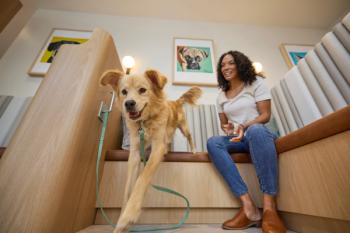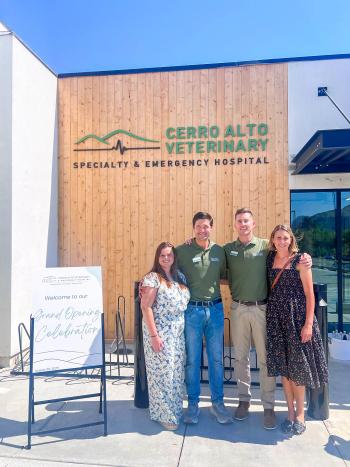
Putting your heart in your practice
Dr. Tim McAughan, a 1978 graduate of Texas A&M University, College of Veterinary Medicine, is no stranger to buying and building facilities. In 1985, he started a practice in a retail center, then moved it to a new facility. In 1997, he bought a second practice in a retail center in Spring, Texas. That, too, needed a freestanding home, he says.
DR. TIM MCAUGHAN, A 1978 GRADUATE OF Texas A&M University, College of Veterinary Medicine, is no stranger to buying and building facilities. In 1985, he started a practice in a retail center, then moved it to a new facility. In 1997, he bought a second practice in a retail center in Spring, Texas. That, too, needed a freestanding home, he says.
"The location had terrible visibility," says Dr. McAughan. "We were in the corner of an L-shaped strip, and a pizza place was built almost in front of us." The old facility also suffered from limited space—only 2,000 square feet—and limited potential for growth.
When Dr. McAughan found some space only a quarter of a mile down the road, he began making plans for his second building project. With experience under his belt, he expected a much easier run this time around. But what he didn't expect was to suffer heart failure and endure two surgeries during the course of the construction.
Building a new facility brings pain, frustration, and fear even to healthy practice owners. And the pain, frustration, and fear of experiencing heart problems during construction should've been enough to stall this project. But Dr. McAughan endured both, and he and Animal Hospital Champions Northwest came out stronger. And to top it all off, the new facility won a 2005 Veterinary Economics Hospital Design Competition Merit Award.
Top, exterior. Middle, reception. Bottom, waiting.
Find good people ...
... and get out of the way. That's Dr. McAughan's philosophy, based on the advice of President Theodore Roosevelt. So Dr. McAughan laid out the features he wanted and needed for his new practice, then hired a great architect and builder to handle the rest.
Hospital design
"Basically, I had put a lot of thought into my first building project, deciding what would go where and how I wanted the building to flow," he says. "Once I had those concepts in my head, it was easier to plan the second facility." Dr. McAughan says he handled most of the functionality and operational flow and left the planning details to the architect and the aesthetic details to his wife. "They're good people, so I gave my input, then let them do the rest."
Having owned and built a previous practice also taught Dr. McAughan what not to do. For example, he included a drive-through for prescriptions and retail items in the first facility. "After 10 years, I'm still having to tell people that we offer this service, even though it's well-marked and right at the front of the building," he says. "It just isn't used enough to justify building another one."
He also changed the way he installed the scrub sink outside of surgery. "It was right at hip height, and we bumped into it all the time," he says. "That led me to recess the sink in this facility, which works a lot better."
A shade-and-noise-barrier wall in the front of the building is Dr. McAughan's favorite architectural feature. "When my architect suggested it, I thought it looked like a giant cheese cutter. But now I love how it works, as a design element and a functional wall—another example of hiring a good person and letting him do his job," he says.
The wall helps keep the hot Western sun from overheating the reception area. And because it extends all the way down one side of the practice, it works as a sound barrier between the boarding and grooming area and the rest of the practice. For extra noise control, the builder installed cinder block, an air gap, and acoustic spray batting, making the wall nearly 20 inches thick.
New building = booming business
After moving in July 2004, business boomed from 6 percent growth per month to 40 percent per month before holding steady at about 30 percent. "Our previous facility was violating the law of location, location, location," says Dr. McAughan. "The new practice is eye-catching and attracts relatively affluent clients who expect a lot from us—so we deliver a lot. That's how we could grow this much."
Left, hospital sign. Top right, treatment. Bottom right, grooming.
Dr. McAughan says he and his team now do what they should've been doing all along. "We didn't really add any new revenue streams, except ultrasound, and we did offer mobile ultrasound before," he says. "But somehow a new facility equals a new attitude, and we're working harder and being more aggressive at diagnostics."
Of course, for Dr. McAughan the new attitude could stem from a renewed happiness with life and with being alive, too. Three years ago, he went to a conference in Georgia to learn how to put a pericardial window in pets. While there, he began feeling chest pain and thought he was having a heart attack. He loaded up on aspirin, tried to relax, and waited until he got home the next morning to visit his doctor, who immediately sent him to the hospital.
Take-away lesson
"The doctor diagnosed pericardial effusion," he says. "That's the irony: I was learning to install pericardial windows in pets when I needed one myself." After the procedure, his health continued to deteriorate until he needed another surgery one month after moving into his new facility.
Happily, Dr. McAughan says his health didn't adversely affect the opening of his practice or hurt his business. "I have good employees, my wife runs the marketing and the books, and I had a great architect and builder, so I didn't have to worry about anything," he says. In fact, Dr. McAughan believes business ran just as well—if not better—without him. And he considers that a great compliment. "I take pride in the fact that my crew could keep the place running and profitable even without me," he says. "It means I hired good people."
Now, a year and a half later, Dr. McAughan is healthy and appreciating his position in life. "I came close to dying," he says. "I'm healthy now, I have my family, and things are working well. Now I just want to plan for my retirement and enjoy what I have.
Sarah A. Moser is a freelance writer and editor in Olathe, Kan. Please send questions or comments to:
Newsletter
From exam room tips to practice management insights, get trusted veterinary news delivered straight to your inbox—subscribe to dvm360.






